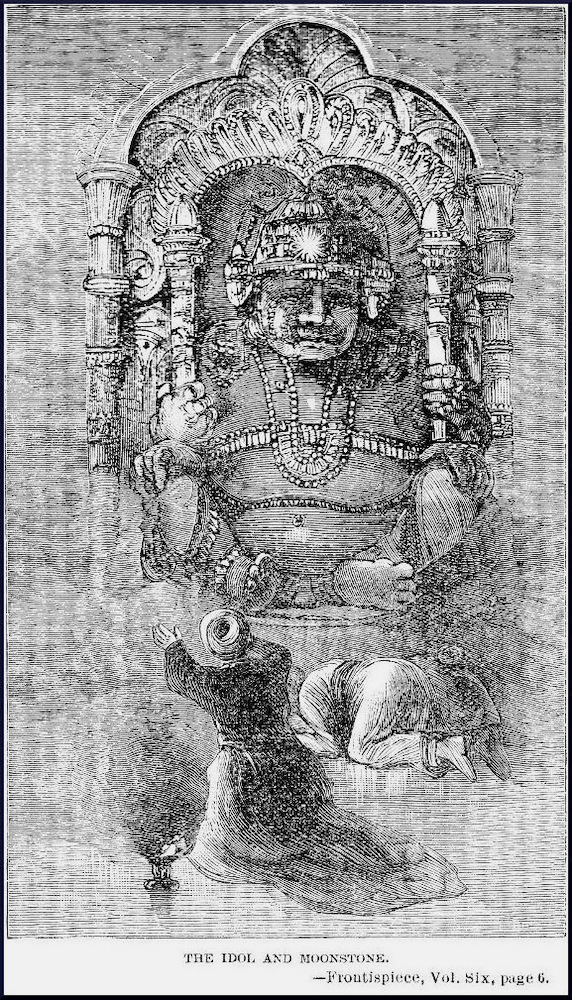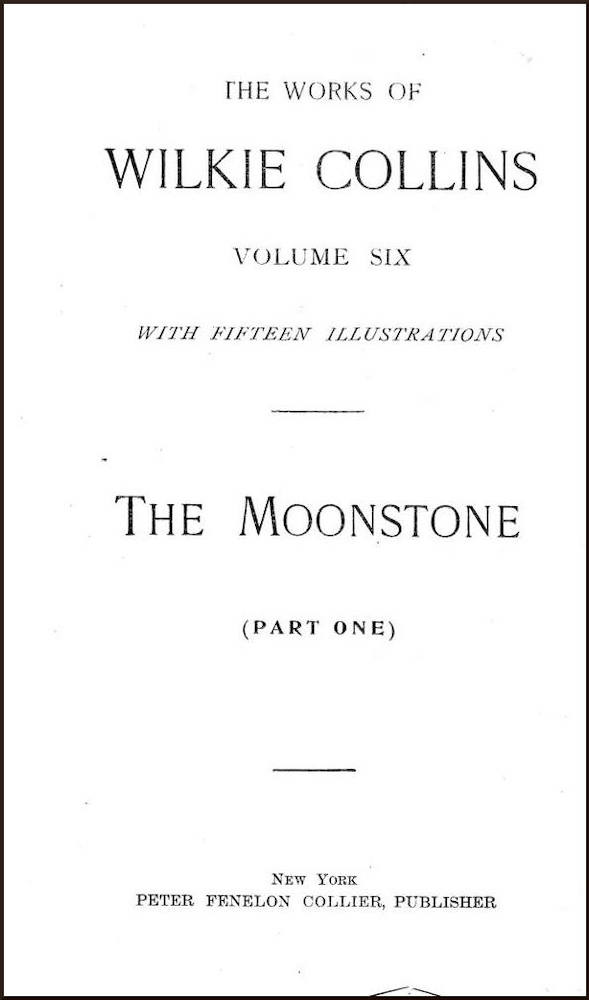

The frontispiece (1900) is based on the very first illustration in the 1868 serialisation Harper's Weekly: A Journal of Civilisation, the 4 January 1868 uncaptioned headnote vignette depicting a much earlier set of Brahmin priests worshipping the Hindu Moon God at his shrine in Benares, the gigantic diamond apparently glowing with its own light in the centre or "third eye" of the statue's forehead. The illustration does not give the viewer a sense of the deity's statue being in the confined space of a Hindu temple. Rather, the American illustrator enshrouds the statue in the voluminous smoke of the incense-burner (lower left), so that the idol and its devotees exist outside conventional space, in an otherworldly or unworldly circumstance that is soon to be violated by foreign conquerers of an entirely different religious faith (in the first instance, the Islamic invaders of India). Thus, the former headnote vignette converted to a frontispiece entitled The Idol and the Moonstone makes manifest Collins's issues of imperial conquest and the timeless devotion of the priests, which parallels the other "romance" of the story, that of Franklin Blake and Rachel Verinder. Wood-engraving, 12.7 cm high by 7.6 cm wide (5 by 3 inches). This is evidence of Harper's having the original serial illustrations re-drafted for volume publication as the original (4 January 1868) vignette was 11.3 cm by 5.5 cm (4 ½ by 3 ¼ inches), and would not have been sufficiently large for a full-page frontispiece. [Click these images to enlarge them.]
Scanned images and text by Philip V. Allingham. [You may use these images without prior permission for any scholarly or educational purpose as long as you (1) credit the person who scanned them and (2) link your document to this URL or cite the Victorian Web in a print one.]
These illustrations appear here by courtesy of the E. J. Pratt Fine Arts Library, University of Toronto, and the Irving K. Barber Learning Centre, University of British Columbia.
Commentary
The overall calibre of the book, particularly the poor-quality paper and its much-reduced program of illustration, implies that it is a cheap re-print, issued in the context of Collier's issuing all of Collins's works in a thirty-volume series. The 1868 novel occupies all of volume 6 ("with fifteen illustrations" out of the total of nineteen) and 190 pages of volume 7, the remaining 412 pages being occupied by The New Magdalen. Other titles in the 1900 series are as follows: Vol. 1, The Woman in White (1860); 2, Short Stories, Part One; 3, Man and Wife (1870) and Short Stories, Part Two; 4, Man and Wife, Part Two; 5, The Law and The Lady (1875); 8, Armadale, Part 1; 9, Armadale (1866), Part 2; 10, Basil (1852), and Little Novels (1887); 11, Hide and Seek (1854); 12, No Name (1862), and Little novels, Part 2; 14, The Queen of Hearts (1857), and Little Novels, Part Three; 15, Poor Miss Finch (1872); 16, The Dead Secret (1874); 17, Antonina; or, The Fall of Rome (1850); 18, The Two Destinies (1876); 19, After Dark (1856); 20, My Miscellanies; 21, The Fallen Leaves (1879); 22, The Haunted Hotel (1879); 23, The Black Robe (1881); 24, The Evil Genius (1885); 25, Heart and Science: A Story of the Present Time (1883); 26, The Legacy of Cain (1888); 27, Jezebel's Daughter (1889); 28, Blind Love (1890); 29, I say No (1884); and 30 A Rogue's Life (1865). None of his eight plays, including The Frozen Deep and No Thoroughfare (upon which he collaborated with Charles Dickens), appear in the collection, which seems to be organised according to popularity rather than by strict chronology of publication.
Related Material
- The Moonstone and British India (1857, 1868, and 1876)
- Detection and Disruption inside and outside the 'quiet English home' in The Moonstone
- George Du Maurier, "Do you think a young lady's advice worth having?" — p. 94.
- Illustrations by F. A. Fraser for Wilkie Collins's The Moonstone: A Romance (1890)
- Illustrations by John Sloan for Wilkie Collins's The Moonstone: A Romance (1908)
- 1910 Frontispiece: "He felt himself suddenly seized round the neck." Page 279.
- The 1944 Illustrations by William Sharp for Wilkie Collins's The Moonstone
- Gallery of Headnote Vignettes by William Jewett for Wilkie Collins's The Moonstone in Harper's Weekly (4 January — 8 August 1868)
Bibliography
Collins, Wilkie. The Moonstone: A Romance. with sixty-six illustrations. Harper's Weekly: A Journal of Civilization. Vol. 12 (1868), 4 January through 8 August, pp. 5-503.
________. The Moonstone: A Romance. All the Year Round. 1 January-8 August 1868.
_________. The Moonstone: A Novel. With many illustrations. First edition. New York & London: Harper and Brothers, [July] 1868.
_________. The Moonstone: A Novel. With 19 illustrations. Second edition. New York & London: Harper and Brothers, 1874.
_________. The Moonstone: A Romance. Illustrated by George Du Maurier and F. A. Fraser. London: Chatto and Windus, 1890.
_________. The Moonstone, Parts One and Two. The Works of Wilkie Collins, vols. 5 and 6. New York: Peter Fenelon Collier, 1900.
_________. The Moonstone: A Romance. With four illustrations by John Sloan. New York: Charles Scribner's Sons, 1908.
_________. The Moonstone: A Romance. Illustrated by A. S. Pearse. London & Glasgow: Collins, 1910, rpt. 1930.
_________. The Moonstone. Illustrated by William Sharp. New York: Doubleday, 1946.
_________. The Moonstone: A Romance. With nine illustrations by Edwin La Dell. London: Folio Society, 1951.
Farmer, Steve. "Introduction" to Wilkie Collins's The Moonstone. Peterborough, ON: Broadview, 1999. Pp. 8-34.
Leighton, Mary Elizabeth, and Lisa Surridge. "The Transatlantic Moonstone: A Study of the Illustrated Serial in Harper's Weekly." Victorian Periodicals Review Volume 42, Number 3 (Fall 2009): pp. 207-243.
Lonoff, Sue. Chapter 7: "The Moonstone and Its Audience." Wilkie Collins and His Readers: A Study in the Rhetoric of Authorship. New York: AMS Studies in the Nineteenth Century, 1982. Pp.
Marshall, William H. Ch. 5, "The Major Novels, 1868-70." Wilkie Collins. New York: Twayne, 1970.
Nayder, Lillian. Unequal Partners: Charles Dickens, Wilkie Collins, & Victorian Authorship. London and Ithaca, NY: Cornll U. P., 2001.
Vann, J. Don. "The Moonstone in All the Year Round, 4 January-8 1868." Victorian Novels in Serial. New York: Modern Language Association, 1985. Pp. 48-50.
Created 27 September 2016
Last updated 13 November 2025